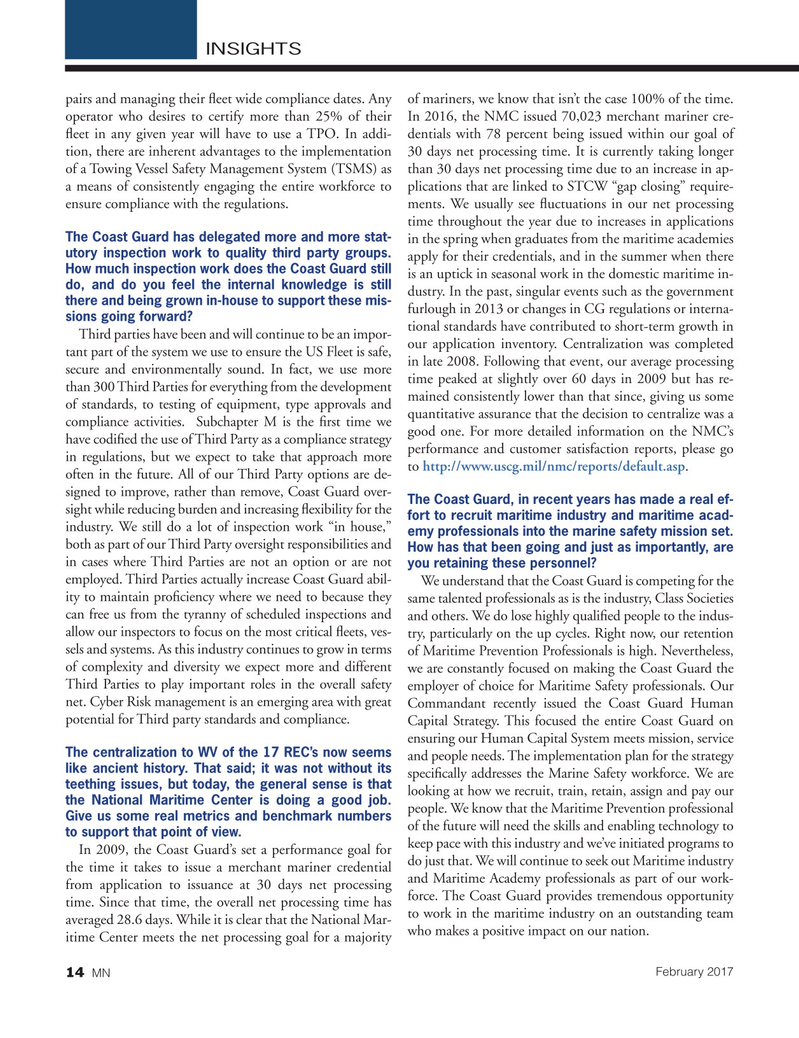
Page 14: of Marine News Magazine (February 2017)
Dredging & Marine Construction
Read this page in Pdf, Flash or Html5 edition of February 2017 Marine News Magazine
INSIGHTS pairs and managing their ? eet wide compliance dates. Any of mariners, we know that isn’t the case 100% of the time. operator who desires to certify more than 25% of their In 2016, the NMC issued 70,023 merchant mariner cre- ? eet in any given year will have to use a TPO. In addi- dentials with 78 percent being issued within our goal of tion, there are inherent advantages to the implementation 30 days net processing time. It is currently taking longer of a Towing Vessel Safety Management System (TSMS) as than 30 days net processing time due to an increase in ap- a means of consistently engaging the entire workforce to plications that are linked to STCW “gap closing” require- ensure compliance with the regulations. ments. We usually see ? uctuations in our net processing time throughout the year due to increases in applications
The Coast Guard has delegated more and more stat- in the spring when graduates from the maritime academies utory inspection work to quality third party groups. apply for their credentials, and in the summer when there
How much inspection work does the Coast Guard still is an uptick in seasonal work in the domestic maritime in- do, and do you feel the internal knowledge is still dustry. In the past, singular events such as the government there and being grown in-house to support these mis- furlough in 2013 or changes in CG regulations or interna- sions going forward?
tional standards have contributed to short-term growth in
Third parties have been and will continue to be an impor- our application inventory. Centralization was completed tant part of the system we use to ensure the US Fleet is safe, secure and environmentally sound. In fact, we use more in late 2008. Following that event, our average processing time peaked at slightly over 60 days in 2009 but has re- than 300 Third Parties for everything from the development of standards, to testing of equipment, type approvals and mained consistently lower than that since, giving us some compliance activities. Subchapter M is the ? rst time we quantitative assurance that the decision to centralize was a good one. For more detailed information on the NMC’s have codi? ed the use of Third Party as a compliance strategy in regulations, but we expect to take that approach more performance and customer satisfaction reports, please go to http://www.uscg.mil/nmc/reports/default.asp.
often in the future. All of our Third Party options are de- signed to improve, rather than remove, Coast Guard over-
The Coast Guard, in recent years has made a real ef- sight while reducing burden and increasing ? exibility for the fort to recruit maritime industry and maritime acad- industry. We still do a lot of inspection work “in house,” emy professionals into the marine safety mission set. both as part of our Third Party oversight responsibilities and
How has that been going and just as importantly, are in cases where Third Parties are not an option or are not you retaining these personnel?
employed. Third Parties actually increase Coast Guard abil-
We understand that the Coast Guard is competing for the ity to maintain pro? ciency where we need to because they same talented professionals as is the industry, Class Societies can free us from the tyranny of scheduled inspections and and others. We do lose highly quali? ed people to the indus- allow our inspectors to focus on the most critical ? eets, ves- try, particularly on the up cycles. Right now, our retention sels and systems. As this industry continues to grow in terms of Maritime Prevention Professionals is high. Nevertheless, of complexity and diversity we expect more and different we are constantly focused on making the Coast Guard the
Third Parties to play important roles in the overall safety employer of choice for Maritime Safety professionals. Our net. Cyber Risk management is an emerging area with great Commandant recently issued the Coast Guard Human potential for Third party standards and compliance.
Capital Strategy. This focused the entire Coast Guard on ensuring our Human Capital System meets mission, service
The centralization to WV of the 17 REC’s now seems and people needs. The implementation plan for the strategy like ancient history. That said; it was not without its speci? cally addresses the Marine Safety workforce. We are teething issues, but today, the general sense is that looking at how we recruit, train, retain, assign and pay our the National Maritime Center is doing a good job. people. We know that the Maritime Prevention professional
Give us some real metrics and benchmark numbers of the future will need the skills and enabling technology to to support that point of view.
In 2009, the Coast Guard’s set a performance goal for keep pace with this industry and we’ve initiated programs to the time it takes to issue a merchant mariner credential do just that. We will continue to seek out Maritime industry from application to issuance at 30 days net processing and Maritime Academy professionals as part of our work- time. Since that time, the overall net processing time has force. The Coast Guard provides tremendous opportunity to work in the maritime industry on an outstanding team averaged 28.6 days. While it is clear that the National Mar- itime Center meets the net processing goal for a majority who makes a positive impact on our nation.
February 2017 14 MN
MN Feb17 Layout 1-17.indd 14 MN Feb17 Layout 1-17.indd 14 1/26/2017 4:35:00 PM1/26/2017 4:35:00 PM

 13
13

 15
15
